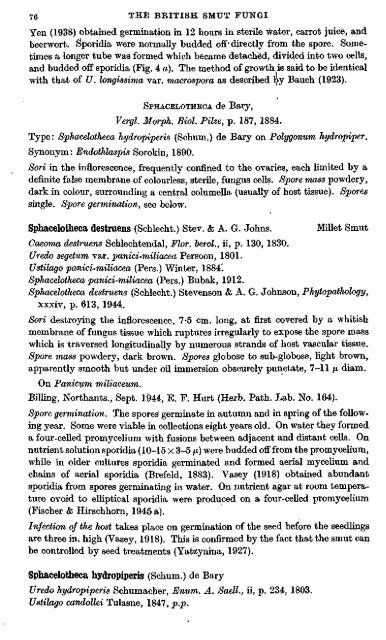nmm sP
nmm sP
nmm sP
You also want an ePaper? Increase the reach of your titles
YUMPU automatically turns print PDFs into web optimized ePapers that Google loves.
76 THE BRITISH SMUT FUNGI<br />
Yen (1938) obtained germination in 12 hours in sterile water, carrot juice, and<br />
beerwort. Sporidia were normally budded off'directly from the spore. Sometimes<br />
a longer tube was formed which became detached, divided into two cells,<br />
and budded off sporidia (Fig. 4 a). The method of growth is said to be identical<br />
with that of U. longissima var. macrospora as described by Bauch (1923).<br />
SPHACELOTHEOA de Bary,<br />
Vergl Morph. Biol. Pilze, p. 187, 1884.<br />
Type: Sphacelotheca hydropiperis (Schum.) de Bary on Polygonum hydropiper.<br />
Synonym: Bndothlaspis Sorokin, 1890.<br />
Sori in the inflorescence, frequently confined to the ovaries, each Umited by a<br />
definite false membrane of colourless, sterile, fungus cells. (Spore mass powdery,<br />
dark in colour, surrounding a central columella (usually of host tissue). Spores<br />
single. Spore germination, see below.<br />
Sphacelotheca destraens (Schlecht.) Stev. & A. G. Johns. Millet Smut<br />
Caeoma destruens Schlechtendal, Flor. berol., ii, p. 130, 1830.<br />
Uredo segetum var. panici-miliacea Persoon, 1801.<br />
Ustilago panici-miliacea (Pers.) Winter, 1884'.<br />
Sphacelotheca panici-miliacea (Pers.) Bubak, 1912.<br />
Sphacelotheca destruens (Schlecht.) Stevenson & A. G. Johnson, Phytopathology,<br />
xxxiv, p. 613, 1944.<br />
Sori destroying the inflorescence, 7-5 cm. long, at first covered by a whitish<br />
membrane of fungus tissue which ruptures irregularly to expose the spore mass<br />
which is traversed longitudinally by numerous strands of host vascular tissue.<br />
Spore mass powdery, dark brown. Spores globose to sub-globose, light brown,<br />
apparently smooth but under oil immersion obscurely punctate, 7-11 ja diam.<br />
On Panicum miliaceum.<br />
Billing, Northants., Sept. 1944, E. F. Hurt (Herb. Path. Lab. No. 164).<br />
Spore germination. The spores germinate in autumn and in spring of the following<br />
year. Some were viable in collections eight years old. On water they formed<br />
a four-celled promyceHum with fusions between adjacent and distant cells. On<br />
nutrient solution sporidia (10-15 X 3-5 /a) were budded off from the promycelium,<br />
while in older cultures sporidia germinated and formed aerial mycelium and<br />
chains of aerial sporidia (Brefeld, 1883). Vasey (1918) obtained abundant<br />
sporidia from spores germinating in water. On nutrient agar at room temperature<br />
ovoid to elliptical sporidia were produced on a four-celled promycelium<br />
(Fischer & Hirschhom, 1945 a).<br />
Infection of the host takes place on germination of the seed before the seedlings<br />
are three in. high (Vasey, 1918). This is confirmed by the fact that the smut can<br />
be controlled by seed treatments (Yatz3niina, 1927).<br />
Sphacelotheca hydropiperis (Schum.) de Bary<br />
Uredo hydropiperis Schumacher, Enum. A. Saell., ii, p. 234, 1803.<br />
Ustilago candollei Tulasne, 1847, p.p.

















